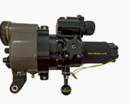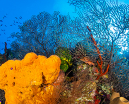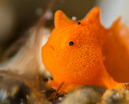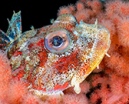Articles

Amazing sailfish images in the forum
Wetpixel Senior Moderator Shawn Heinrichs has posted some amazing images of a recent trip to Isla Mujeres, Mexico onto the forum. The trip was aimed specifically at capturing images and interacting with the sailfish that hunt sardines in the area. Shawn describes the trip:
“Day one we landed a 3 hour bait ball and another 2 hour bait ball. Day 2 was much the same. Day 3 and 4 I was off the boat and the success continued without me. Day 5 we regrouped and found sails again, but this time conditions had turned and we called it an early day. Overall the trip was a huge success and everyone came back with epic imagery.”
Some of those magnificent images and video are now on the forum, please click through to check them out.

Underwater Photography Magazine issue 65 available
Issue 65 of Underwater Photography (UwP) magazine is now available to download. Featured in the March/April 2012 edition are articles by Phil Rudin on “Mirrorless Macro”, “Fish Faces” by Angel Cegarra, Mark Webster on “Lembeh Luxury” and “Isla de Coco” by Alex Tyrell. Other items include a DVD review of a Photoshop Elements 9 tutorial, Barbados Sea Turtles and Red Sea tourism. As always, UwP is also full of news, views and product releases.
Issue 65 has a parody of the Beatles’ White Album as its cover and is available as a free download in pdf format.

Canon announces the 5D Mark III SLR
As expected, Canon has announced the release of the 5D Mark III SLR. The new camera features a 22.3 megapixel CMOS sensor, a DIGIC 5+ image processor which gives a continuous shooting speed of 6 fps and a 61 point AF system. It also has enhanced video capabilities, including 1080p video at 24p (23.976), 25p, and 30p (29.97) fps and 720p HD recording at 60 (59.94) and 50 fps, as well as a new H-264 video codec, SMPTE compliant timecode and improved rendering without moire and color artifacts. Native ISO is from 100 to 25,600, with 50, 51,200 and 102,400 available.
The 5D Mark III has a built-in HDR mode and dual card slots. It will be available from the end of March 2012, at a retail price of $3,499.00 for a body.

Time for a major philosophy change
Wetpixel Associate Editor Alex Mustard has provoked a fascinating and lively debate in the forums by asking:
The issue is: with changes in camera technology, should we still strive for the finished image in camera, or not?”
He relates it to the advent of the Lytro camera which allows for focus adjustments post-capture, and the imminent arrival of the Nikon D800 and Canon 5DMk III, both of which have massive resolution and will promote the use of extensive cropping. Does the concept of getting the image right at the moment of capture still have merit or not? Please join the discussion and add your thoughts.
I think this will be a fascinating thread to revisit in a few years time!

Lytro light field cameras start shipping
Lytro has started shipping its first cameras to US customers. Whilst housings and underwater equipment for the camera are not yet commercially available, it is apparent that the technology is going to change the way pictures are taken and as Wetpixel Publisher, Eric Cheng is Director of Photography at Lytro, I’m sure they will be going underwater soon. Ren Ng, Founder and CEO of the company said:
“Six years ago, I wrote in my PhD dissertation: “I find that this new kind of photography makes taking pictures that much more enjoyable, and I hope you will too. I look forward to the day when I can stand in the tall grass and learn from fellow light field photographers shooting in the field.” That day has arrived – see you out there!

Study investigates lionfish hunting techiques
A study published in the Marine Ecology Progress Series journal shows that the invasive red lionfish (Pterois volitans) blow directed jets of water at prey fish to disorient them. These jets may overwhelm the target’s lateral line, part of a fish’s nervous system that detects vibrations and warns of approaching objects and prey often end up facing the hungry lionfish, increasing the chances of head-first strikes and lowering the risk of the lionfish getting stuck by backwards-facing spines. The research team first observed this behavior while monitoring lionfish populations off Lee Stocking Island in the Bahamas. It is interesting to note that less lionfish use this technique in the Atlantic than in the Pacific, possibly emphasizing that the Atlantic fishes are easier to catch due to them being less habituated to the predators.
The full journal paper available to download as a free pdf.

Wetpixel Picture of the Year 2011 results announced
Wetpixel’s Picture of the Year 2011 competition has now finished. Many thanks to all who voted for their favorite images and it is great to have had so strong a response to all the images. The winner, who will receive a trip on Solmar V as a prize, is Alexis Tabah, with his turtle hatchling in Snell’s window. Second prize went to Nicholas Samaras, third to Dany Weinberg, fourth to Stephen Holinski and fifth to AlexTattersall. They will all receive prizes from Ikelite, Nauticam USA or Reef Photo and Video.
The competition has received a staggering amount of public interest, with the winning images getting over 2,500 votes each. Congratulations to all Picture of the Week winners, and especial congratulations to the winners of Picture of the Year 2011.

Study links shark fin to brain disease
A study published in the journal Marine Drugs links the consumption of shark fin and shark products, including dietary supplements, to neurodegenerative diseases in humans including Alzheimer’s and Lou Gehrig Disease. This is due to the presence of high concentrations of a neurotoxin called BMAA in the shark products. The study was carried out by scientists from the University of Miami, and is reported on the Rosenstiel School of Marine and Atmospheric Science’s blog. Most significantly, the study suggests:
“That consumption of shark fin soup and cartilage pills may pose a significant health risk for degenerative brain diseases.”










